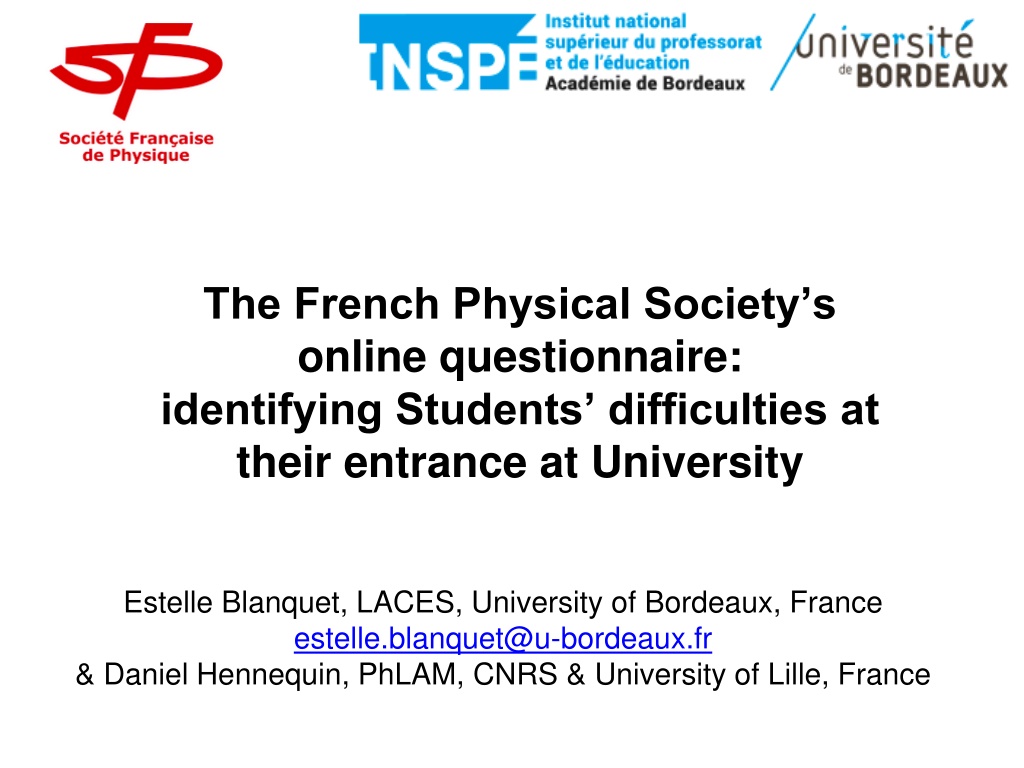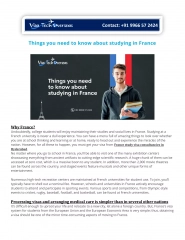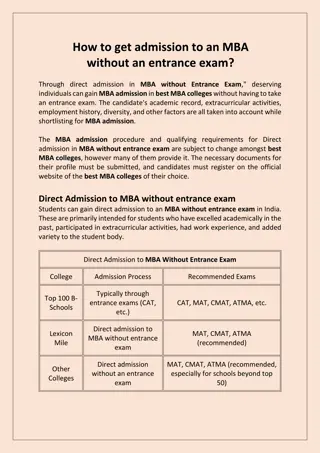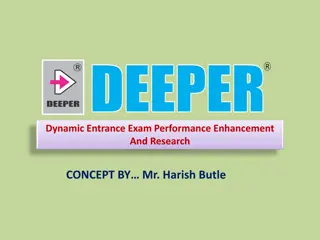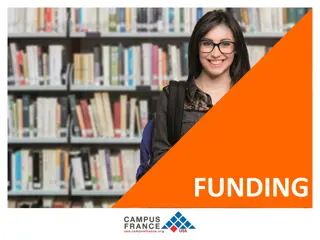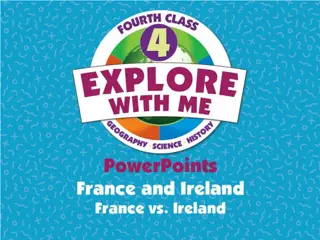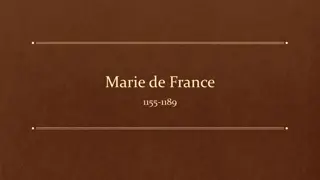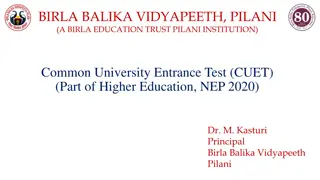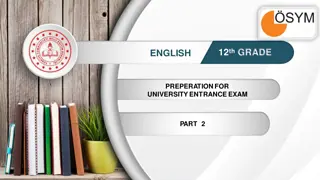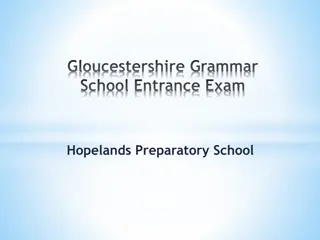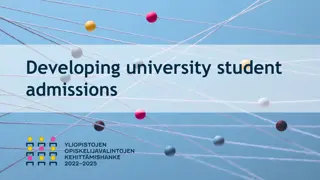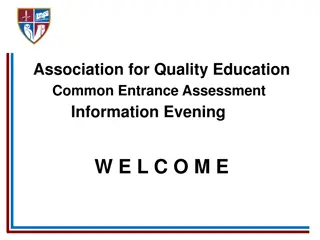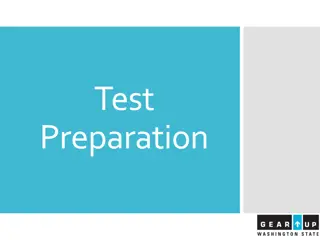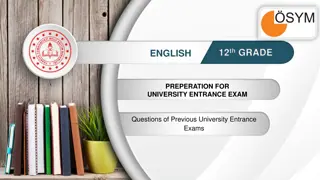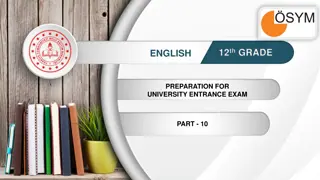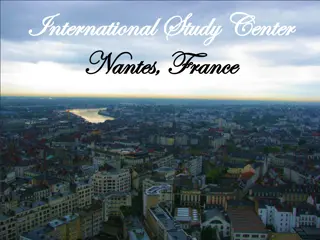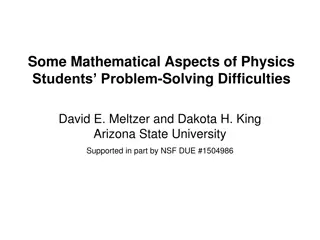Understanding Students' Difficulties at University Entrance in France
The French Physical Society conducted an online questionnaire to identify obstacles faced by students entering university in France. The traditional access method through a national exam has a high success rate, but concerns about the students' preparedness persist. Different educational paths post-high school create challenges in adapting courses to help students succeed. Lack of national data hampers monitoring student evolution levels. To address these issues, a national, anonymous multiple-choice questionnaire was proposed, covering various subjects relevant to the high school curriculum, with a focus on testing conceptual understanding.
Download Presentation

Please find below an Image/Link to download the presentation.
The content on the website is provided AS IS for your information and personal use only. It may not be sold, licensed, or shared on other websites without obtaining consent from the author. Download presentation by click this link. If you encounter any issues during the download, it is possible that the publisher has removed the file from their server.
E N D
Presentation Transcript
The French Physical Societys online questionnaire: identifying Students difficulties at their entrance at University Estelle Blanquet, LACES, University of Bordeaux, France estelle.blanquet@u-bordeaux.fr & Daniel Hennequin, PhLAM, CNRS & University of Lille, France
The French Context: too easy an access to university? - access to university traditionaly determined by a national examination taken by all students in their final year at high school, the Baccalaur at (K12, 18 years old) - yet, its present success rate (over 90%) no longer guarantees a satisfactory level - French universities are legally obliged to accept all passed students - enrolment is mostly free
French Context: selective vs. Non-selective cursus University: Bachelor degree in Physics non-selective access Engineering school, integrated course after the baccalaureate, selective OR BTS and DUT: 2-year post-baccalaureate courses, aimed at rapid integration into professional life, selective OR Classes Pr paratoires: preparatory courses for engineering schools, selective OR
Choosing university: a very minority choice among students taking physics in high school
=> scientific university tracks deal with students who are often already in difficulty. They thus have to adapt their courses to help them succeed. => there is no national indicator to monitor the evolution of students' levels and to provide an overview
a first observation: a lack of national data A first issue: what are the impacts of the reforms? A second issue: What are the actual difficulties of the students entering higher education?
A nation-wide and anonymous multiple choice questionnaire - Four parts linked to the French high school curriculum: mathematics, waves, mechanics, general knowledge - questions based on Science Education research testing the understanding of concepts (almost no calculations) or on basic content - about a hundred questions ( I don t know always an option) - lasting about an hour - online test, accessible on students' mobile phones - easy to implement (less than two minutes for a teacher)
Basic mathematics - n objects cost x euros, how much do 6 objects cost? nx/6 ; 6x/n ; 6n/x - 1 cubic centimetre corresponds to: 1dL / 1cL / 1 mL - 100 mL of soup contains 80 kJ. A 25 cL plate contains: 20 / 320 / 200 kJ - We have the relation U=RI. U remains constant. When R increases : I increases / decreases / stays constant - in a cube of 10 cm side, how many cubes of 1 cm side do you put? 100 / 1000 / 10 000
Waves - the louder a sound is, the faster it travels through the air: True / False - A sound wave of frequency 100 Hz travels at 300 m.s-1. Its wavelength is: 3m / 3.104m / 30 000 m - as the period of a wave increases, its frequency increases: True / False - sound waves are electromagnetic waves corresponding to wavelengths outside the visible range: True / False - when a sound becomes higher the frequency: increases/decreases
Mechanics - A child is on a merry-go-round. His mother, sitting on a bench, sees it spinning at a constant speed. In relation to the child, it is not the merry-go-round but his mother who is spinning: True / False - A train moves at a constant speed in a straight line horizontally. A passenger drops his wallet. It falls: far behind him/far in front of him/at his feet - For an observer sitting in a meadow watching the train go by and for a passenger on the train sitting watching the event, the forces on the wallet are the same: True / False - In a Galilean frame of reference, two bodies of different masses are subjected to an identical force. The one subject to the greater acceleration is: the most massive / the less massive
Mechanics - A soccer-player kicks a ball. The action of the air is neglected. As the ball rises, there are two forces acting on it: its weight and a force tangential to the movement: True / False - The pull of the Sun on the Earth is much greater than the pull of the Earth on the Sun: True / False - On a flat road, a person pushes his broken-down car. The force he exerts on the car is greater than the force the car exerts on him: True / False - A juggler is in a tram that moves at a constant speed in a straight horizontal line. To catch the balls he throws, he has to throw them: a little in front of him / vertically as if he were on solid ground - A juggler (wearing a spacesuit) is on the moon. He moves in a straight line at a constant speed. To catch his balls, he has to throw them: a little in front of him / vertically as if he were standing still
General knowledge - As altitude increases, atmospheric pressure increases: T/ F - The boiling temperature of water increases with altitude: T/ F - Helium can be cooled to -290 C: T/ F - A stone and a feather are dropped on the Moon from the same height. They arrive on the ground at the same time: T/ F - It is warmer in summer than in winter because the Earth is closer to the Sun: T/F - An ice cube / vodka is taken from the freezer (-18 C) and its temperature is measured immediately. What do we find? -18 C / -10 C / 0 C
Uni 2013 2014 2015 2016 2020 2021 2022 Scores (%) inf= 49 28,8 % 33,3 % 32,4 % 27,8% 34,0 % inf= 59 33,2 % 31,3 % 36,4 % 29,3% 38,4 % inf= 70 24,1 % 24,7 % 21,3 % 26,3% 22,5 % sup 70 13,9 % 10,7 % 9,8 % 16,5% 5,2 % effectif 713 336 225 133 365 Pr pa 2013 2014 2015 2020 2021 2022 Scores (%) inf= 49 6,9 % 4,8 % 12,3 % 26,5 % 17,8 % inf= 59 25,1 % 34,9 % 26,4 % 25,3 % 32,0 % inf= 70 32,7 % 33,3 % 29,5 % 25,1 % 28,5 % sup 70 35,3 % 27,0 % 31,8 % 23,1 % 21,7 % effectif 637 63 1839 921 659
Basic mathematics - n objects cost x euros, how much do 6 objects cost? nx/6 ; 6x/n ; 6n/x 2022 Pr pa 70% / University 63% 2013 Pr pa 79% / University 68 % - in a cube of 10 cm side, how many cubes of 1 cm side do you put? 100 / 1000 / 10 000 2022 Pr pa 67% / University 58% 2013 Pr pa 72% / University 52%
Waves - A sound wave of frequency 100 Hz travels at 300 m.s-1. Its wavelength is: 3m / 3.104m / 30 000 m 2022 Pr pa 59% / University 50% 2013 Pr pa 74% / University 53% - sound waves are electromagnetic waves corresponding to wavelengths outside the visible range: True / False 2022 Pr pa 52% / University 36% 2013 Pr pa 74% / University 49%
Mechanics - A train moves at a constant speed in a straight line horizontally. A passenger drops his wallet. For an observer sitting in a meadow watching the train go by and for a passenger on the train sitting watching the event, the forces on the wallet are the same: True / False 2022 Pr pa 43% / University 40% 2013 Pr pa 41% / University 39% - In a Galilean frame of reference, two bodies of different masses are subjected to an identical force. The one subject to the greater acceleration is: the most massive / the less massive 2022 Pr pa 51% / University 45% 2013 Pr pa 51% / University 46%
Mechanics - A soccer-player kicks a ball. The action of the air is neglected. As the ball rises, there are two forces acting on it: its weight and a force tangential to the movement: True / False 2022 Pr pa 33% / University 17% 2013 Pr pa 43% / University 28% - The pull of the Sun on the Earth is much greater than the pull of the Earth on the Sun: True / False 2022 Pr pa 47% / University 33% 2013 Pr pa 64% / University 48% - A juggler (wearing a spacesuit) is on the moon. He moves in a straight line at a constant speed. To catch his balls, he has to throw them: a little in front of him / vertically as if he were standing still 2022 Pr pa 29% / University 28% 2013 Pr pa 26% / University 30%
General knowledge - Helium can be cooled to -290 C: T/ F 2022 Pr pa 36% / University 29% 2013 Pr pa 40% / University 36% - It is warmer in summer than in winter because the Earth is closer to the Sun: T/F 2022 Pr pa 53% / University 51% 2013 Pr pa 51% / University 48% - An ice cube / vodka is taken from the freezer (-18 C) and its temperature is measured immediately. What do we find? -18 C / -10 C / 0 C 2022 Pr pa 52% / University 42% 2013 Pr pa 58% / University 48%
Findings - Classes pr paratoires students have better scores than university s students - There is a decrease of understanding of concepts by both categories of students between 2013 and 2022 - The questionnaire allows to identify math-related difficulties which may become obstacles to learning physics - The questionnaire reveals the persistence of classic misconceptions => A useful tool for teachers and students
Thank you ! qcm.sfpnet.fr Contact : estelle.blanquet@u- bordeaux.fr
